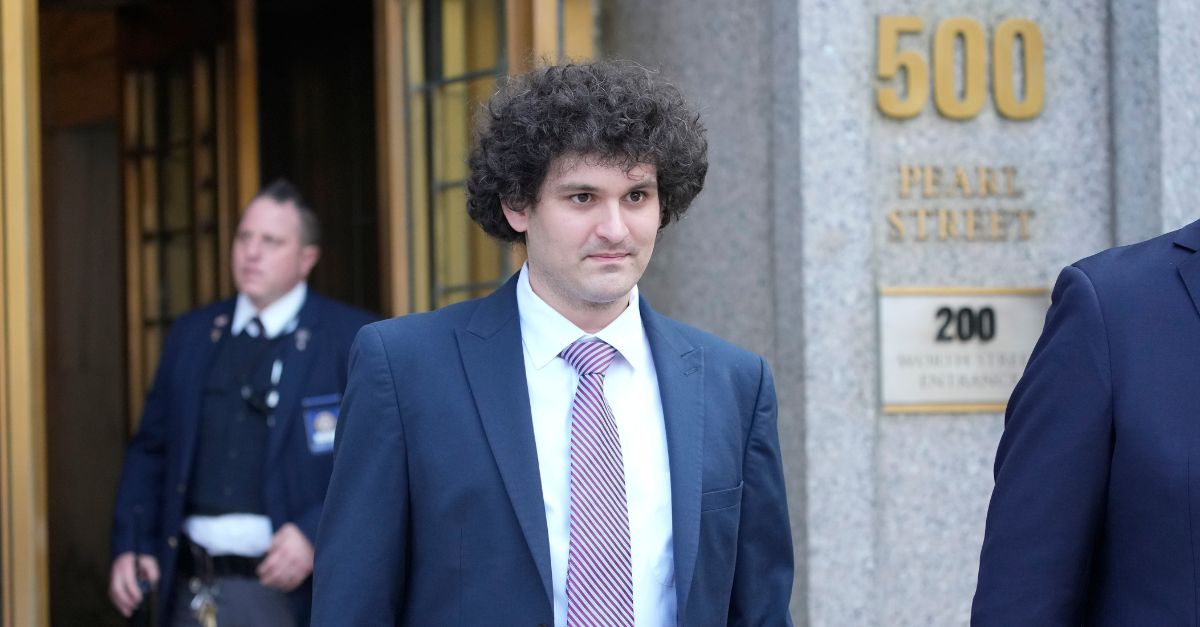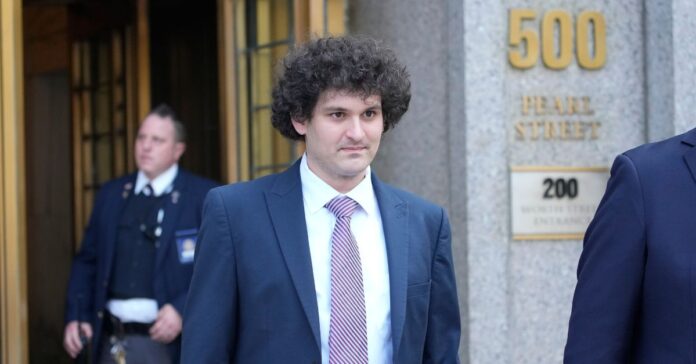
FTX founder Sam Bankman-Fried leaves Federal court, Wednesday, July 26, 2023, in New York. (AP Photo/Mary Altaffer)
The son of Stanford law professors who went on to be convicted of a cryptocurrency fraud damaging enough to be mentioned in the same breath as Bernie Madoff’s Ponzi scheme has been sentenced to 25 years in federal prison.
Sam Bankman-Fried, the so-called “crypto king” oft identified as SBF, appeared before Senior U.S. District Judge Lewis Kaplan in the U.S. District Court for the Southern District of New York on Thursday morning to learn his punishment for the collapse of his cryptocurrency exchange FTX. By the time the hearing neared its end, it was clear to court watchers that the judge was not buying the defense push for leniency on the notion that victims would necessarily be “made whole” through bankruptcy.
It’s apparent that Judge Kaplan gives no weight to the defense arguments that FTX fraud victims may be made whole via the bankruptcy process.
This sentencing will not go well for SBF. https://t.co/pBc9begFI2
— Renato Mariotti (@renato_mariotti) March 28, 2024
Judge Kaplan: For the reasons well articulated by Mr. Ray, that people will be paid back is speculative. So I find the loss amount readily exceeds $550 million, the top tier. I find investors lost $1.7 billion, lenders lost $1.3 billion, and customers, $8 billion
— Inner City Press (@innercitypress) March 28, 2024
In mid-March, prosecutors asked the judge to sentence the defendant to 40-50 years in prison for his wire fraud and conspiracy crimes, countering the 6.5 years proposed by the defense. In the government’s sentencing memo, prosecutors emphasized that Bankman-Fried, 32, caused “billions of dollars in losses and significant harm to tens of thousands of victims financially and emotionally,” no matter what the defense claimed about the degree to which victims suffered or continue to suffer.
Following his December 2022 arrest in the Bahamas, Bankman-Fried was returned to the U.S. to face his federal indictment. The government had accused the Democratic megadonor who also donated to Republicans of masterminding “a scheme to defraud customers of FTX by misappropriating billions of dollars of those customers’ funds” — spending on himself and investing “millions of dollars of political contributions to candidates from both parties, and to repay billions of dollars in loans owed by Alameda Research,” Bankman-Fried’s crypto trading firm.
The defendant then rooked both Alameda Research lenders and FTX equity investors “by providing them false and misleading financial information that concealed his misuse of customer deposits,” the DOJ said in summarizing the case. In reality, the government went on, Bankman-Fried “channeled billions of dollars in customer deposits from FTX to Alameda, and then used those funds to make investments for his own benefit, to make political contributions, and to spend on real estate, among other expenditures.”
In a letter to Judge Kaplan days later, Bankman-Fried lawyer Marc L. Mukasey asserted that the government’s proposed punishment was “disturbing” in its adoption of “a medieval view of punishment to reach what amounts to a death-in-prison sentencing recommendation.”
Prosecutors painted the defendant as a “depraved super-villain” with “megalomaniacal motives” even though “there were never losses,” the defense claimed.
“Section 3553 allows the Court to consider that the bankruptcy proceeding will result in customers and lenders being made whole as of the bankruptcy petition date. The government, predictably, downplays this fact. The truth is, there were never losses. The money has always been available. Assets remain,” the defense asserted. “Each victim quoted in the government’s opposition will receive 100 cents on the dollar — plus interest. This would be impossible if the estate’s assets had disappeared into Sam’s personal pockets.”
What followed the next day on the court docket were victim accounts from FTX and Alameda Research disputing that the defense’s position that bankruptcy proceedings would take care of the problem.
“As the lead professional of a very large team who has spent over a year stewarding the estate from a metaphorical dumpster fire to a debtor-in-possession approaching a confirmed plan of reorganization that will return substantial value to creditors, I can assure the Court that each of these statements is categorically, callously, and demonstrably false,” FTX CEO John Ray said. “The value we hope to return to creditors would not exist without the tens of thousands of hours that dedicated professionals have spent digging through the rubble of Mr. Bankman-Fried’s sprawling criminal enterprise to unearth every possible dollar, token or other asset that was spent on luxury homes, private jets, overpriced speculative ventures, and otherwise lost to the four winds.”
Even still, Ray said, there cannot be a “true, full economic recovery” through bankruptcy “as if the fraud never happened.”
Rather, he explained, victims have reason to be “extremely unhappy.”
“In other words, a victim who had bitcoin on the FTX exchange on November 11, 2022 will receive, as the Bankruptcy Court has determined, a distribution based on the value of the claim on that date, which is approximately 400% lower than the value today,” Ray said. “Because the value of certain cryptocurrencies has risen sharply since the petition was filed, many of Mr. Bankman-Fried’s victims are extremely unhappy with the ‘petition date value’ provided for under the law.”
The victim impact statement from FTX also highlighted Google documents that Bankman-Fried wrote in after the bankruptcy filing, detailing possible ways to spin the crisis of his own making in his favor, even if it meant throwing lawyers under the bus for purported “f—ups” preventing victims from being made whole.
At the same time, Ray said, the defendant contemplated the “exact opposite approach” in the same Google document.
“Go strong with the message I’m really glad the Chapter 11 team has stepped in, they’re great, and even better I have funding that can help make customers more whole while the Chapter 11 team does what is needed to clean things up,” the defendant said.
Ray stated that it was clear that “customers, non-governmental creditors, governmental creditors, and non-insider stockholders have suffered and continue to suffer” from Bankman-Fried’s crimes.
On the eve of the sentencing hearing, even more victim impact statements on the “FTX Disaster” told numerous stories of those who were bilked of part, the majority, and even all of their life savings due to Bankman-Fried’s fraud.
After hearing from the parties on Thursday, Judge Kaplan sentenced the defendant to two-and-a-half decades behind bars and ordered Bankman-Fried to forfeit $11 billion.
“I reject entirely that there was no actual loss,” the judge reportedly said.
The U.S. Attorney’s Office for the Southern District of New York celebrated the 25-year sentence as “an important message” to anyone else out there contemplating on embarking on “one of the largest financial frauds in history.”
U.S. Attorney Damian Williams said Bankman-Fried stole “over $8 billion of his customers’ money” in order to “secretly” strengthen “his own power and influence,” only to, “in some cases,” wipe out victims’ life savings.
U.S. Attorney General Merrick Garland also weighed in, highlighting the interest the case garnered in the upper echelons of the DOJ.
“There are serious consequences for defrauding customers and investors. Anyone who believes they can hide their financial crimes behind wealth and power, or behind a shiny new thing they claim no one else is smart enough to understand, should think twice,” Garland said. “I am grateful to the U.S. Attorney’s Office for the Southern District of New York and the FBI for their outstanding work in bringing Mr. Bankman-Fried to justice.”
Have a tip we should know? [email protected]

